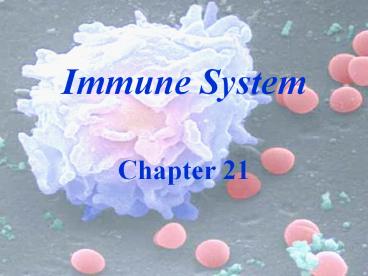Immune System - PowerPoint PPT Presentation
1 / 28
Title: Immune System
1
Immune System
- Chapter 21
2
(No Transcript)
3
Nonspecific Defenses
- Species resistance - docking sites on cells only
allow certain pathogens to attach. Ex you cant
get - Tobacco mosaic virus
- Dutch elm disease
- Distemper
4
- Mechanical Chemical Barriers
- 1st Line of Defense
- Skin and mucous membranes
- Stomach - HCl
- Tears - lysozyme
- Hair
5
- 2nd Line of Defense
- Inflammation chemotactic proteins
- Phagocytosis macrophages and neutrophils
6
- Natural Killer Cells tumor cells and cells with
viral infections - Interferon anti-viral proteins
- Complement Proteins causes lysis of antigen
- Fever
7
2nd line of defense Inflammatory Process
- White blood cells (WBC) are released
- Monocytes, macrophages, neutrophils, eosinophils,
natural killer cells - Blood vessels expand near the wound or entry.
- Swelling occurs (caused by histamine) which
increases body temperature to kill off pathogens - Basophils released
8
Specific Cellular Defenses
- Overview of Immune Response
- Humoral Immunity
- Provided by antibodies
- Produced by lymphocytes
- Bind to bacteria and free floating viruses
9
- Cell Mediated Immunity
- Special lymphocytes direct the attack of infected
cells - Attack cancer cells, parasites, transplants
- Release chemicals to mediate OR stimulate other
parts of the immune system
10
- Antigens
- Large molecules that interact and respond to
cells and immune chemicals - Antibodies
- Native antigens immunoglobulins
11
- Humoral Immunity (B-Cell Immunity)
- Produced in the bone marrow
- Produce antibodies
- Stimulated by antigens and/or lymphokines
12
- 2 types of B cells
- Plasma cells make antibodies (2000/sec) and
memory cells - Memory cells remain for a lifetime to produce
more antibodies if antigen returns
13
- Antibodies
- 5 classes
- IgD attached to B cells act as a receptor
sites - IgM RBC, food and bacterial markers stimulates
complement proteins agglutinating agent
14
- IgG main antibody tissue marker, virus,
bacteria and toxin antibody - IgA found in milk, tears, urine, sweat
prevents attachment of pathogens to epithelial
tissues - IgE associated with allergies cause release of
histamine
15
(No Transcript)
16
- Responsible for 1o and 2o immune response
- 1o - initial exposure to antigen, plasma cells
produce antibodies lag time - 2o subsequent exposure to previous antigen
produce 1000s of antibodies within hours
17
- Types of Antibody Immunity
- Acquired Immunity
- Active artificial vaccine of the antigen
(measles) requires boosters - Passive artificial vaccine of antibodies from
another infected animal (rabies)
18
- Natural Immunity
- Active natural get the disease lifetime
immunity - Passive natural mothers antibodies are passed
to fetus prior to birth short-term
19
- Cell-Mediated Immunity
- T cells
- Originate and mature in the thymus
- Must become tolerant to bodys own proteins so
as not to react to them - Can only recognize an antigen when it is bound
to another immune cell
20
- Secrete lymphokines to stimulate cloning of
other immune cells - 4 types
- Cytotoxic (killer) T cells secrete perforin
which lyses target cells - Helper T cells direct cloning of other T B
cells through secretion of lymphokines
21
- Suppressor T cells dampens activity of killer
helper cells - Delayed hypersensitivity T cells play role in
allergies and chronic inflammation
22
Organ Transplants
- 4 Types of transplants (grafts)
- Autografts self to self always successful
- Isografts identical twins always successful
23
- Allografts same species used most often
complications due to tissue typing - Xenografts different species rarely successful
24
- Following transplantation
- Anti-inflammatory drugs
- Cytotoxic drugs
- Radiation
- Cyclosporin to suppress production of
interleukins, Helper T and Cytotoxic T cells
without stopping production of already sensitized
B cells
25
- Rejection
- Early inadequate blood supply to graft
- Late burst of unexplained antibodies
26
Homeostatic Imbalances
- Immunodeficiencies
- Autoimmunity
27
- Hypersensitivities body responds to a harmless
antigen - Immediate hypersensitivity- within minutes
- Cytotoxic hypersensitivity transfusion reactions
28
- Immune-complex hypersensitivity strep, malaria,
chronic viral infections cause rashes, swollen
lymph nodes - Delayed hypersensitivity poison ivy, cosmetics































